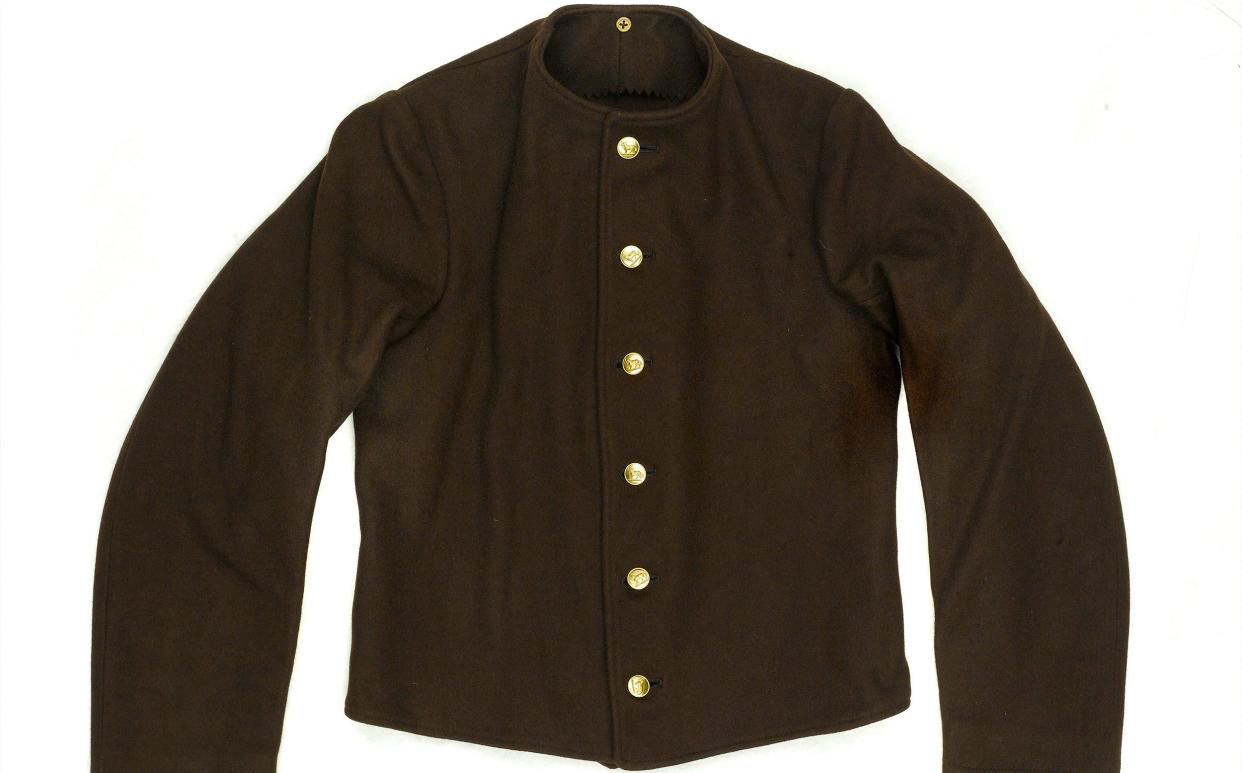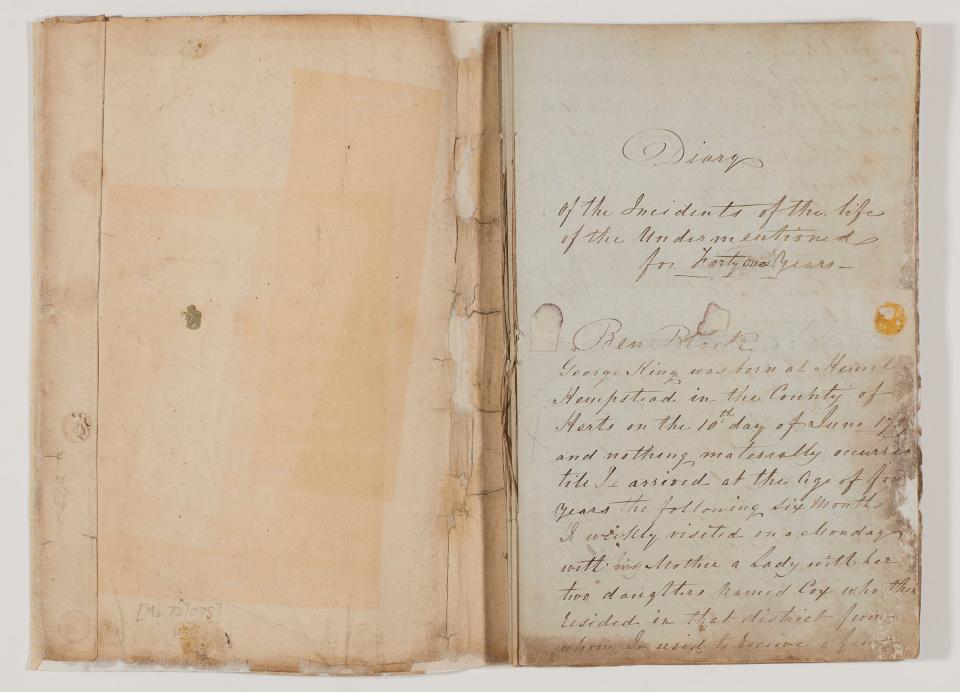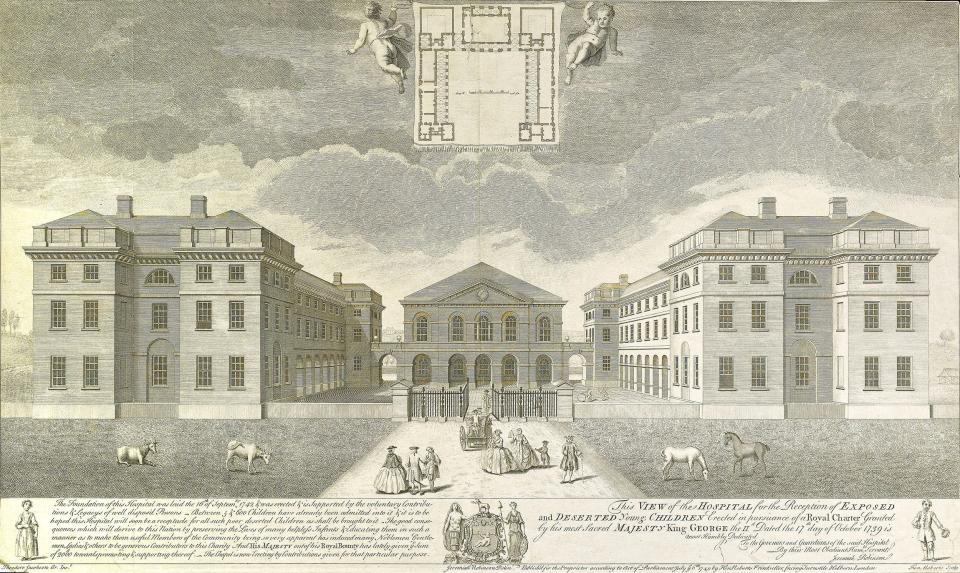The orphan hero who fought with Nelson at Trafalgar

- Oops!Something went wrong.Please try again later.
Naval life 200 years ago was not for the faint-hearted. In the late summer of 1808, a third-rate ship of the line of the Royal Navy, HMS Polyphemus, stood at anchor in the Gulf of Mexico. After six months at sea, yellow fever decimated its crew. Among victims of the mosquito-borne virus was the ship’s purser, “a very stout able man” in the view of his shipmates. His body was duly sewn up in a hammock and cast overboard “with usual church ceremonies.” It was not, however, the last of Davies the Purser that his former crewmates were to see.
Davies’s posthumous fate survives in a remarkable document at the centre of a new exhibition at London’s Foundling Museum. Fighting Talk: One Boy’s Journey from Abandonment to Trafalgar focuses on the role played by Foundling Hospital orphans in Britain’s military life and workforce two centuries ago. The document – an autobiography written by George King – is the only known narrative of its sort: a self-penned life story by a former beneficiary of Britain’s first children’s charity, the residential children’s home called the Foundling Hospital that was founded by Thomas Coram in 1739.
King, like Davies, was among Polyphemus’s crew; he saw at first hand what happened to the amply built purser. “Innumerable quantity of sharks,” King noted, attended Polyphemus. The ship’s first lieutenant lowered a baited hook into the sea. A bite swiftly followed. Burton the boatswain helped drag in the catch of a large shark. He cut off its head and sliced it open. The spectacle caused understandable excitement. The ship’s carpenter discovered that his 2ft wooden ruler was six inches too short to measure the full span of the shark’s jaw.
There was more to come. Men hauled the gaping carcase onto the ship’s deck and set about examining their gory catch. “On Burton ripping his belly open,” records King, “the first thing that presented itself was a man’s leg and thigh… the next was one arm and half his back. The next came his other leg and thigh and afterwards the other arm and half his body.” Matter-of-factly, King notes that the shark’s belly did not contain a human head. After brief examination, “by the size of the limbs it was judged to be Davies the purser’s steward”, who was then returned limb by limb to the deep.
The combination of startling detail, boyish gusto and straightforward reportage is typical of King’s autobiography. Inspiration for the current exhibition is his account of Polyphemus’s presence at the Battle of Trafalgar in 1805, when King himself was 17 and in his first year of naval service. Newly commissioned photographs by the British artist Ingrid Pollard respond to details in his account; also on show are his Naval General Service Medal and items of navalmen’s uniform.

Yet King’s autobiography illuminates more than historic battles. Throughout, his ebullient spirit is engaging. In January 1807, for instance, Polyphemus docked in Portsmouth. King found himself on English soil for the first time in three years. “I being so much overjoyed and four guineas in my pocket I took a run and did not feel the ground under me. I think a greyhound wou’d hardly head me for the first hundred yards,” he writes. Inevitably, it ended badly. With a group of shipmates, he drank “five or six” glasses of hot grog at an inn in Portsmouth High Street. He passed out, awaking to find his pockets empty of his four guineas. In a sequel typical of the camaraderie that recurs throughout King’s account, he caught up with his shipmates who “mustered between nine and ten shillings for me.” On another occasion, when a member of the crew received a letter from his mother telling him that her cow had died, a whip-round below decks yielded £20 for the purchase of a replacement for the struggling widow.
George King was born in Hemel Hempstead in June 1787. When he was four, his mother travelled with him to London and placed him in the Foundling Hospital as child number 18,053, her decision presumably forced upon her by poverty. Little George appears to have found a parent substitute in a kindly teacher, Robert Atchinson. “I took a liking to learn my lessons for which I frequently got small presents from my Schoolmaster,” he writes: “all things went on gaily while I was at school.” At the age of 11, he was rewarded with a prize of a shilling for his copy of “a Writing from my Schoolmaster addressed to the Treasurer of the School.” Visitors to the current exhibition will agree with Atchinson’s estimate of the quality of King’s handwriting: as preserved in his autobiography, its loops and curlicues and forward-leaning tilt are indeed as lovely as the swirling printed script on another exhibit, a 1749 engraving of Henry Roberts’ View of the Foundling Hospital.

When he was 13, the Hospital arranged for King to be apprenticed to a confectioner in Fleet Street. As with Atchinson, he appears to have been fortunate in his master, John Browne, who mostly treated him with kindness and trust. The teenage King was no more or less virtuous than the average teenage boy: after he “began to spring up in height” around his fifteenth birthday, he also developed a bent for a brawl. “A regular turn-to” with one of the shop’s porters lasted 20 minutes; another time he threw a pan of scalding water over the senior apprentice “who used often to give me a blow”. In July 1804, after one too many such scrapes, he ran away to Chatham docks. There – green in appearance, young and naif – he was press-ganged and “a few hours afterwards… found [him]self on board His Majesty’s Ship Polyphemus”.
Naval history enthusiasts will delight in King’s record of battle formations, his descriptions of life below deck and evocative details like the tattered appearance of Nelson’s fleet after Trafalgar: “a few days previous to behold them newly painted outside, it now appeared as if they had been laid at moorings for years’. King himself emerges from his writing in the guise of lovable rogue, with a poor head for drink but undoubted bravery in his silent acceptance of the floggings that were his punishment for drunkenness. Perhaps shaped by first experiences, his is a devil-may-care outlook. After negotiating an increase in his naval pension in 1832, following 24 years’ service, he set out for America, apparently intending “to try for employment on the railroad as a painter”. In fact, he became a teacher in Walterborough, South Carolina, on an annual salary of $200.
The southern States would not remain King’s home: he returned to England and, failing to secure long-term employment as hop picker or docker, was taken in by the Royal Naval Hospital in Greenwich. For weeks he had “lived upon nothing but bread and coffee”: his relief is palpable. Like his childhood – much to the exhibition visitor’s relief – King’s last years were spent in the relative security of an institution for the poor, provided with food, gentle occupation and a dignified uniform of the sort illustrated in Henry James Pidding’s Prisoners Outside the Chapel at Greenwich Hospital of 1844. He died in 1857. A century-and-a-half later, his autobiography enables us to assess the contribution made by foundlings like King to naval history and to hear for ourselves this liveliest of lost voices.
Fighting Talk: One Boy’s Journey from Abandonment to Trafalgar Oct 15-Feb 27 foundlingmuseum.org.uk

